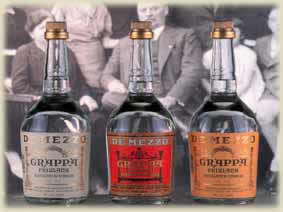Grappa. A name that stands for heritage, a genuine Italian
culture
This is a product that can well stand the comparison with the great
brands of distillation.
Grappa boasts ancient origins and maybe because of its long history
has managed to become popular in the past centuries, acquiring its peculiar
personality for which it is today ever more estimated by connoisseurs.
Not only in Italy.
But there was still a long way to go to reach Grappa.
Until the onset of the seventeenth century, distillate
was always made from wine and never from marc.
We owe the discovery that alcohol could be obtained out of marc to a
Jesuit, Atanasio Kircher, and to the Italian brother Francesco Terzi
Lana.
This is the "official" story.
However from ancient documents we gather that in Friuli and Veneto already
in the fifteenth and sixteenth century the inhabitants traded grappa
abroad.
And maybe we should go a little backwards, in those times when it was
customary after fermentation of the must had ended, that "masters"
and "servants" would share out the product thus obtained,
to the former the wine, to the latter the marc.
And probably some servant tried to do what the master did with wine
(that is distilling) and fearing that the master would keep also the
marc, the secret was kept for a long time.
Secrets for a better tasting
First of all the right glass must be chosen, in this
case a tulip-shaped glass; pour the chosen grappa into the glass; sip
it slowly trying to feel tastes, odours, and peculiar body: tasting
grappa is sheer pleasure, but tasting has its own rules which must be
strictly followed.
Tasting grappa is not an easy task, because of its high alcohol content,
between 40° and 60° and its volatile substances vanish rapidly.
However, let's try to set some basic parameters, starting from classification.
Grappe may be divided into young, kept for ageing in non-wood containers
, where they have refined their characteristics, and aged ones when
they have "lived" for a certain period of time in wooden casks,
of different wood types, such as oak or ash acquiring different features
from those they showed at the beginning.
There are aromatic types of grappe (such as moscato grappa, malvasia
an so on); aromatic grappe obtained through maceration with officinal
herbs (rue, gentian and so on).
In order to evaluate a grappa it is necessary to take three parameters
into consideration: the "visual" analysis which assesses limpidity
and colour hue of the distillate.
The "olfactory" evaluation which considers the volatile elements
of grappa.
For this type of evaluation experience is required because the odours
deriving from three groups of chemical compounds must be recognised
and "felt": ester, aldehyde and alcohol.
In order to analyse the sensations deriving from the most volatile elements
the glass must be kept still; rotating the distillate in the glass enables
a more complete olfactory analysis.
Finally there is the taste analysis intended to "discover"
the tastes of grappa: sweet, sour and bitter.
The perfect balance among the three tastes makes an excellent grappa.
Taste of grappa is said to be flat if it lacks acidity, short if the
sensations vanish rapidly, dry if there are few sweet elements, round
if the aroma is harmonious.

Our Friulian Grappe

